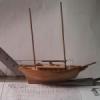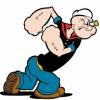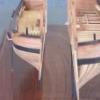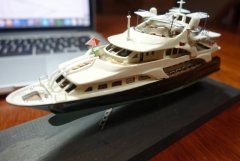-
Posts
5,619 -
Joined
-
Last visited
Reputation Activity
-
 Jack12477 got a reaction from PeteB in USCG Pequot (WARC-58) by captainbob - FINISHED - 1:96
Jack12477 got a reaction from PeteB in USCG Pequot (WARC-58) by captainbob - FINISHED - 1:96
Bob, here's the link to the Coast Guard Historian's web page where I found the information. And here's a link to a PDF file listing all the hull numbers including your boat. Their site says the W designation started in 1942, but not sure how long it took to implement fleet wide. Nice photo of her in 1944.
-
 Jack12477 reacted to Erik W in HM Cutter Cheerful 1806 by Erik W - 1:48 scale
Jack12477 reacted to Erik W in HM Cutter Cheerful 1806 by Erik W - 1:48 scale
Now that the keel, false keel, and bulkheads are together, I thought it would be a good idea to build a build board/cradle to hold the Cheerful upright. I also built a jig out of scrap wood to gently, but securely, hold the ship upside-down when I need it held for fairing and planking. While I was cutting lumber, I also referenced the Cheerful plans to make two curved sanding blocks, one for the bow curvature, and one for the more gradual curve at the stern.
I threw in a photo of my work area. This is in the spare room/office in my house. I model with a small footprint. I'm not typical of a lot of modelers . . . in that I'm a neat freak! I have a vacuum cleaner, and small shop vac in the closet of the room. You can see, with the larger size of the Cheerful, I had to adjust my lighting height by adding a stand for my lamp . . . made out of the same 1 x 6 I bought for the build board.
Erik
-
 Jack12477 got a reaction from cog in Marie Jeanne by Jack12477 - FINISHED - Artesania Latina - 1:50 scale
Jack12477 got a reaction from cog in Marie Jeanne by Jack12477 - FINISHED - Artesania Latina - 1:50 scale
Thanks for explanation.
In the photo below what is the beam (red arrow) used for? Dans la photo ci-dessous ce qui est le faisceau (flèche rouge) utilisé?
-
 Jack12477 got a reaction from popeye the sailor in Marie Jeanne by Jack12477 - FINISHED - Artesania Latina - 1:50 scale
Jack12477 got a reaction from popeye the sailor in Marie Jeanne by Jack12477 - FINISHED - Artesania Latina - 1:50 scale
Update:
Thanks Mobbsie, David and Michael for the advice and especially Michael for the photos.
Don't have quite the narrow brass bands shown in Michael's photos but do have some 24 gauge and 26 gauge brass wire I can use as a starter. I used the heavier gauge wire to simulate the bolt(s) and the thinner for the strop. Bending the loop in the strop was done with a jewelry making pliers I picked up in one of the craft stores. The chainplate on the left in the photo below needs a little adjustment and all need a little cleanup with a Dremel or something. I used medium CA to cement them in place (haven't gotten a chance to practice soldering yet so I didn't want to risk it on this piece).
First attempt:
Current progress - nothing is glued down, just set in place to gauge overall appearance.
-
 Jack12477 got a reaction from dgbot in USCG Pequot (WARC-58) by captainbob - FINISHED - 1:96
Jack12477 got a reaction from dgbot in USCG Pequot (WARC-58) by captainbob - FINISHED - 1:96
Bob, here's the link to the Coast Guard Historian's web page where I found the information. And here's a link to a PDF file listing all the hull numbers including your boat. Their site says the W designation started in 1942, but not sure how long it took to implement fleet wide. Nice photo of her in 1944.
-
 Jack12477 got a reaction from avsjerome2003 in Birch Plywood
Jack12477 got a reaction from avsjerome2003 in Birch Plywood
I get mine in the local Michaels craft store and none of the pieces I looked thru were warped. The had them down to 1/8 thickness. Saw a couple pieces of 1/16 "airplane" plywood but wasn't too impressed with it. Most of the sheets were 8 x 8 or 12 x 12 with some 4 x 8 (all inches not feet).
-
 Jack12477 got a reaction from mtaylor in Birch Plywood
Jack12477 got a reaction from mtaylor in Birch Plywood
I've used it a lot but only in the 3/8 and 1/2 inch thicknesses. Works fine for jigs and portable work tables for me. Haven't used it for model keels or bulkheads tho.
-
 Jack12477 reacted to Cathead in Buying an Expensive Kit and throwing most of it away
Jack12477 reacted to Cathead in Buying an Expensive Kit and throwing most of it away
You make use of forums like this, and elsewhere, to research kits and manufacturers. There is a wealth of personal experience and testimony about the subject, here alone much less on the internet at large. You look for build logs for that kit, and read what experience builders had. You then contact those builders and ask their further opinion. You post a general question, if it hasn't already been asked, about a given manufacturer and kit. It's why MSW has this section:
Particularly if you aren't experienced with kits, actually handling the kit may or may not teach you much (for example, misunderstanding the laser burn marks as a defect), whereas crowd-sourcing opinions and reviews from many builders will given you a better understanding of the kit or company overall.
I've purchased three kits, each of which I researched in this way, and each of them as been as I expected when I opened the box because I did my homework online.
In an ideal world, we could all also go to a nice local hobby store with floor-to-ceiling kit boxes to peruse, but almost none of this live in that world. The next best stage is learning from our peers, and I've found that I can trust the folks here to provide useful and accurate information.
-
 Jack12477 reacted to Cathead in Buying an Expensive Kit and throwing most of it away
Jack12477 reacted to Cathead in Buying an Expensive Kit and throwing most of it away
If you're judging all possible model kits by the one kit you saw from one manufacturer, that's your loss.
-
 Jack12477 reacted to mtaylor in Birch Plywood
Jack12477 reacted to mtaylor in Birch Plywood
I can't comment on the size, but a lot of the hobby places carry it. I've used it and it works. Just make sure you don't get warped pieces which seems to be a big part of the offerings lately.
-
 Jack12477 got a reaction from WackoWolf in Bomb Vessel Granado 1742 by gjdale - FINISHED - 1/48 - Cross-Section
Jack12477 got a reaction from WackoWolf in Bomb Vessel Granado 1742 by gjdale - FINISHED - 1/48 - Cross-Section
Grant, start here and follow down thru Michael Mott's post. This might work with the channel's you've already made, which by the way look fantastic.
-
 Jack12477 reacted to pete48 in Haven 12 1/2' by pete48 - 1" = 1' Scale - Joel White version
Jack12477 reacted to pete48 in Haven 12 1/2' by pete48 - 1" = 1' Scale - Joel White version
Thank You, Patrick, She's right on the money, I could not be more pleased, this boat sure is a lot of fun to build, The Herreshoff Mfg. method to build this boat makes a lot of sense and is straightforward
Thank You, Jack, Yes, I am familiar with the Herreshoff Ice Yacht, I have the copy of Wooden Boat laying around here somewhere with an article on it. That is Awesome that you were able to see one ( pretty amazing stuff )
Best Regards,
Pete
-
 Jack12477 got a reaction from mtaylor in Haven 12 1/2' by pete48 - 1" = 1' Scale - Joel White version
Jack12477 got a reaction from mtaylor in Haven 12 1/2' by pete48 - 1" = 1' Scale - Joel White version
Since you are talking about Herreshoff designed boats, are you aware of his Ice Yacht Slipper? The only ice yacht (boat) he designed. I had the pleasure of seeing it under sail on the Hudson River in March 2014. I have pictures if you want me to post them. Also Wooden Boat magazine did an article complete with plans on it in their January/February 2005, Number 182 edition. The tiller/rudder is unique in that it has a sprocket and chain drive. It is presently owned by someone in CT.
-
 Jack12477 got a reaction from mtaylor in USCG Pequot (WARC-58) by captainbob - FINISHED - 1:96
Jack12477 got a reaction from mtaylor in USCG Pequot (WARC-58) by captainbob - FINISHED - 1:96
Bob, according to my friends at our local USCG station, today's color scheme is black hull with white cabin for "working" boats, e.g. tugs, buoy tenders, ice breakers, etc and white hull with white cabin for Search & Rescue (SAR) and Law Enforcement boat. The Polar Ice Breakers are a red hull.
-
 Jack12477 got a reaction from PeteB in USCG Pequot (WARC-58) by captainbob - FINISHED - 1:96
Jack12477 got a reaction from PeteB in USCG Pequot (WARC-58) by captainbob - FINISHED - 1:96
Bob, in addition to the color scheme, all USCG boats 65 feet or longer are called Cutters and given a name as well as a hull number. Boats less than 65 feet in length are just given a hull number and the first two digits of the number give you the hull length, e.g. 44nnn is a 44 ft, 36nnn is a 36 ft, etc. Starting in WW II all Coast Guard cutters were designed with the letter W followed by a alphanumeric scheme to distinguish them from US Navy vessels. This applies to both black hull and white hull boats. Some of the newer special purpose boats have orange hulls but these are generally less than 30 ft boats, example, the Rigid Hull Inflatables used for harbor security and similar functions.
Hope this helps
-
 Jack12477 reacted to pete48 in Haven 12 1/2' by pete48 - 1" = 1' Scale - Joel White version
Jack12477 reacted to pete48 in Haven 12 1/2' by pete48 - 1" = 1' Scale - Joel White version
I started Today, by finishing the rabbet line cut between the stem and keel and faired in the rabbet at the transom. I then started lining off the ribs for the planking, there are 10 planks per side ( port & starboard ) I then laid out the garboard plank ( you only have to lay out one side and use it as a pattern for the other side ) cut the garboards out and placed them in rubbing alcohol. I then laid out the broad strake and did the same as the garboard. I then ( after a 2 hour soak ) pulled the garboard out 1 at a time worked the bends and installed them to the keel and ribs. Next I did the same with the broad strake's. Next will be to continue the planking. here are the reswults
-
 Jack12477 reacted to pete48 in Haven 12 1/2' by pete48 - 1" = 1' Scale - Joel White version
Jack12477 reacted to pete48 in Haven 12 1/2' by pete48 - 1" = 1' Scale - Joel White version
Hi Michael, there are quite a few other Herreshoff boats H28 comes to mind there was a recent article in Wooden Boat about building one. ( wich is interesting since there is a complete set of drawings for the boat in sensible cruising designs ) The Gill Smith boats are Amazing as well
Best Regards,
Pete
-
 Jack12477 reacted to michael mott in Haven 12 1/2' by pete48 - 1" = 1' Scale - Joel White version
Jack12477 reacted to michael mott in Haven 12 1/2' by pete48 - 1" = 1' Scale - Joel White version
Thanks for the clarification Pete. I must say that I have spent a long time this past few weeks looking at pictures of all three boats. I am also a big fan of one of Herreshoff's other gems Gloriana......
And just to stir it up a bit
Gill Smith's Pauline a cat boat
Michael
-
 Jack12477 got a reaction from mtaylor in USCG Pequot (WARC-58) by captainbob - FINISHED - 1:96
Jack12477 got a reaction from mtaylor in USCG Pequot (WARC-58) by captainbob - FINISHED - 1:96
Bob, in addition to the color scheme, all USCG boats 65 feet or longer are called Cutters and given a name as well as a hull number. Boats less than 65 feet in length are just given a hull number and the first two digits of the number give you the hull length, e.g. 44nnn is a 44 ft, 36nnn is a 36 ft, etc. Starting in WW II all Coast Guard cutters were designed with the letter W followed by a alphanumeric scheme to distinguish them from US Navy vessels. This applies to both black hull and white hull boats. Some of the newer special purpose boats have orange hulls but these are generally less than 30 ft boats, example, the Rigid Hull Inflatables used for harbor security and similar functions.
Hope this helps
-
 Jack12477 got a reaction from Omega1234 in USCG Pequot (WARC-58) by captainbob - FINISHED - 1:96
Jack12477 got a reaction from Omega1234 in USCG Pequot (WARC-58) by captainbob - FINISHED - 1:96
Bob, according to my friends at our local USCG station, today's color scheme is black hull with white cabin for "working" boats, e.g. tugs, buoy tenders, ice breakers, etc and white hull with white cabin for Search & Rescue (SAR) and Law Enforcement boat. The Polar Ice Breakers are a red hull.
-
 Jack12477 reacted to EdT in Young America 1853 by EdT - FINISHED - extreme clipper
Jack12477 reacted to EdT in Young America 1853 by EdT - FINISHED - extreme clipper
Young America - extreme clipper 1853
Part 134 – Capstans 2
In the last post the top, mortised section of the drumhead was inverted and glued on the base turning to produce the square mortises shown in the first picture.
In this picture the piece has been turned to the final 34” diameter of the head. The top part was then turned carefully to fit the 32” i.d. of the top brass ring. When a snug fit was produced at the end of the turning, that diameter was taken down to the seat of the ring – about 2” above the mortises. The excess material was then parted off the top of the head as shown below.
Enough was left to produce the rounded up top of the head which was then turned. The cutter was then set at the depth of the ring seat, backed off a measured amount, moved to the left to cut the lower ring seat, then dialed back down to that diameter. The head was then parted off and the rings pressed on as shown below.
In this picture the rings have been cemented with thin CA glue and the top polished. The next step was to make the 14” diameter spindles.
As shown above, a cherry turning square was fixed in a four-jaw self-centering chuck and held for turning with a dead center at the tailstock end. In the next picture one of the two drumheads is being test fitted over its spindle.
The head was then glued to the spindle and the brass cap cemented into place. In the next picture the flats for the 8 whelps are being filed on the spindle below the drumhead.
I had initially intended to mortise slots for these but the small size and the relative softness of the cherry left an undesirable result after milling, so I decided to simply file flats using the spaces between the head mortises as a guide. The whelps were then made and glued on. After the glue dried the whelps were secured with two epoxied bolts each. Lower disks were also made and fitted to each. The two capstan assemblies at this point are shown below.
The whelps on the left capstan in the picture have been rounded concave and the wire bolts have been filed off flush. The spindle on this capstan has also been cut to final length and a pin inserted in the bottom that will secure it at the step on the deck below. This will be the main deck capstan. The one on the right will be mounted on the forecastle.
In the next part the iron baseplates with their pawl stops and the underlying wood bases will be made. Some details of the baseplate can be seen on the drawing in the above picture.
Ed
-
 Jack12477 reacted to gjdale in Bomb Vessel Granado 1742 by gjdale - FINISHED - 1/48 - Cross-Section
Jack12477 reacted to gjdale in Bomb Vessel Granado 1742 by gjdale - FINISHED - 1/48 - Cross-Section
Thanks Dan,
Coming from a professional model builder, your kind words are especially appreciated. Thanks also for posting pics from your QAR - that method might well be the "winner"! I'll have a closer look today
-
 Jack12477 reacted to gjdale in Bomb Vessel Granado 1742 by gjdale - FINISHED - 1/48 - Cross-Section
Jack12477 reacted to gjdale in Bomb Vessel Granado 1742 by gjdale - FINISHED - 1/48 - Cross-Section
Thanks Jack,
I had a look at your log last night, after Ken sent the link through. Nice work, by the way!
-
 Jack12477 reacted to hornet in The Kit-Basher's Guide To The Galaxy
Jack12477 reacted to hornet in The Kit-Basher's Guide To The Galaxy
Hi Captain Steve
I use a similar method with a bit of a 'twist' so to speak. I have taken two different diameter brass nails and cut off the heads. I filed one side of the top of each nail flat so that I could drill a 0.8mm hole through each. The nails were then whipped into dowel handles. Using two different diameter nails allowed for different sided rings and hooks. Rings are produced in the same manner as you demonstrated except that I start by placing the brass wire in the hole before wrapping it around the nail. This allows more 'grip' and produces a 'tighter' ring. Hooks are made similarly. I place one end of the brass wire in the hole, bend to shape then cut the wire, reverse it and bend again. I usually then place them in my fly tying vice and silver solder before blackening with Birchwood Casey Brass Black.
Cheers
Steve
-
 Jack12477 reacted to Chuck in Build Log Titles - A Reminder
Jack12477 reacted to Chuck in Build Log Titles - A Reminder
Just bumping this up to the top...I have noticed many NOT-SO-NEW members creating really bad build log titles. At least pretend to follow the rules......Thanks
Unless you just expect a moderator to t=do the work for you...please create appropriate build log titles......Thank You








